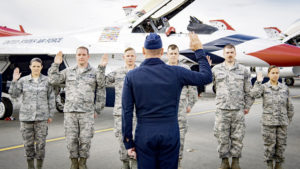
The Department of the Air Force is seeing its highest retention levels in 20 years, second only to rates recorded shortly after 9/11 in 2002.
However, as hundreds of members who were previously planning to retire or separate in 2020 withdrew or delayed their departures amidst COVID-19 concerns, it led to fiscal year 2021 end strength numbers that already exceeded the projected end-of-year goals.
“Congress delivered immense help, increased our numbers and helped us make real readiness improvements after sequestration reductions,” said Lt. Gen. Brian Kelly, deputy chief of staff for manpower, personnel and services. “Increased recruiting and retention efforts helped restore the size of the force by nearly 23,000 over the last five years. We also closed a 4,000-person maintainer gap and increased the manning levels of many career fields.”
Now, Kelly said, the challenge for the Department is to keep the size of the force balanced for the future, high-end fight.
To get that done, headquarters personnel teams are reviewing voluntary opportunities to allow for even more flexibility as Airmen make long-term career choices. These will involve waivers of some active duty service commitments, particularly focused on expanding opportunities to affiliate with the Guard and Reserve.
“We want Airmen to know their expertise is incredibly valuable, and we are reviewing steps to make it even easier to either transition to Guard or Reserve service or explore other career fields,” he said.
Kelly also noted the service may no longer need all the retention bonuses the force is currently using, and will “shape the force to better match our requirements by facilitating re-training from some over-manned AFSCs to those with lower manning levels.”
Kelly said involuntary programs are not being considered for FY21.
“We have to bring in the right number of Airmen each year to sustain the force throughout the continuum of service,” Kelly said. “We have a plan to avoid future year-group gaps and we will announce volunteer options soon that we believe will balance end-strength appropriately.” Kelly expects to share the approved list of volunteer options before mid-December.
As the Space Force is still in a purposeful phase of strategic growth, any force management decision will be evaluated for its applicability to the newly formed sixth branch of service. Space Force members will not be eligible for a voluntary ADSC waiver due to the required minimum two years to join the new service.
“As we build the Space Force, our priority has been to do no harm and to communicate decisions with the maximum transparency possible as we transfer personnel from the Air Force into the new service,” said Patricia Mulcahy, U.S. Space Force chief human capital officer. “We remain committed to that goal as we work with our partners in the Air Force to find effective solutions in addressing these force management concerns.”


